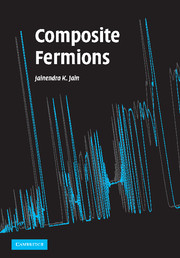Book contents
- Frontmatter
- Contents
- Preface
- List of symbols and abbreviations
- 1 Overview
- 2 Quantum Hall effect
- 3 Landau levels
- 4 Theory of the IQHE
- 5 Foundations of the composite fermion theory
- 6 Microscopic verifications
- 7 Theory of the FQHE
- 8 Incompressible ground states and their excitations
- 9 Topology and quantizations
- 10 Composite fermion Fermi sea
- 11 Composite fermions with spin
- 12 Non-composite fermion approaches
- 13 Bilayer FQHE
- 14 Edge physics
- 15 Composite fermion crystals
- Appendixes
- References
- Index
3 - Landau levels
Published online by Cambridge University Press: 07 December 2009
- Frontmatter
- Contents
- Preface
- List of symbols and abbreviations
- 1 Overview
- 2 Quantum Hall effect
- 3 Landau levels
- 4 Theory of the IQHE
- 5 Foundations of the composite fermion theory
- 6 Microscopic verifications
- 7 Theory of the FQHE
- 8 Incompressible ground states and their excitations
- 9 Topology and quantizations
- 10 Composite fermion Fermi sea
- 11 Composite fermions with spin
- 12 Non-composite fermion approaches
- 13 Bilayer FQHE
- 14 Edge physics
- 15 Composite fermion crystals
- Appendixes
- References
- Index
Summary
The appearance of the Planck constant h in the formula for RH is an indication of the inherently quantum mechanical nature of the effect. In this chapter, we study a single electron confined to two dimensions and exposed to a magnetic field. This problem was solved exactly soon after the invention of quantum mechanics (Darwin; Fock; Landau), because it is merely a one-dimensional simple harmonic oscillator problem in disguise. The most remarkable aspect of the solution is that the electron kinetic energy is quantized. The discrete kinetic energy levels are called “Landau levels.”
The Landau level is the workhorse of the quantum Hall problem. The integral quantum Hall effect is seen below as a direct consequence of the Landau level formation. The explanation for the fractional quantum Hall effect, which is caused by interactions, requires further insights, but Landau levels again provide the key analogy: the effect arises because the lowest Landau level splits into Landau-like energy levels (called Λ levels).
This chapter deals with Landau levels in two geometries: planar and spherical. Two gauges are used in the planar geometry, the Landau and the symmetric gauges. The spherical geometry considers an electron moving on the surface of a sphere, subjected to a radial magnetic field. Wrapping the plane on to the surface of a sphere is simply a choice of boundary conditions, which should not affect the bulk properties of the state.
- Type
- Chapter
- Information
- Composite Fermions , pp. 26 - 76Publisher: Cambridge University PressPrint publication year: 2007

